Tamron AF 18-270mm f/3.5-6.3 Di II VC Aspherical
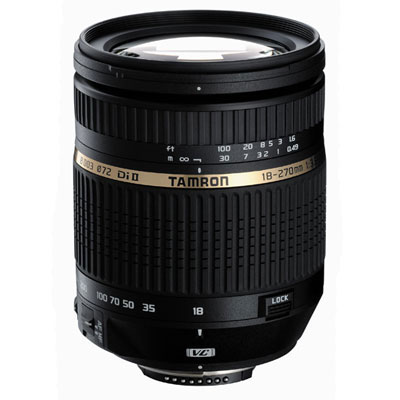 |  ePHOTOzine lens expert, Gary Wolstenholme casts his keen eye over the 15x Tamron AF 18-270mm f/3.5-6.3 Di VC LD Aspherical (IF). |
Tamron AF 18-270mm f/3.5-6.3 Di II VC LD Aspherical: Handling and features
With a zoom range of 15x, The Tamron 18-270mm is intended to be a lightweight and convenient all-in-one solution for APS-C sized sensor cameras. This lens covers an incredible range from moderate wide-angle, through to super-telephoto range, albeit at a relatively modest maximum aperture. On Canon DSLRs with a 1.6x crop, this lens gives a 35mm format equivalent of 29-432mm; with Nikon 1.5x crop DSLRs it's 27-405mm. In theory, this one compact lens can cover all your photographic needs. The Vibration Compensation feature promises to allow shooting in lower lighting conditions without camera shake ruining the image quality.
Plastic is used for most of the construction of this lens, which makes for a very lightweight design with the only metal part being the lens mount. The quality of the materials is good, feeling solid enough for general use. The wide rubberised zoom ring takes up most of the body of the lens and its action is quite smooth, although it does tighten up at around 100mm. A zoom lock is provided to prevent the lens from extending during transport, although this will not prevent the zoom creeping forward during shooting, which I found does happen when the camera is tilted down and the lens is zoomed in a little. The lens balances well on intermediate bodies such as the Nikon D90 or Canon EOS 50D, but feels a little large to me on smaller bodies such as the Nikon D3000 or Canon EOS 500D. The low weight of the lens means it still balances well on entry-level bodies though.
Autofocus is achieved via a motor built into the lens. It is not the silent (USM or HSM) type found on many modern zooms, so a noise can be heard during focusing. Focusing is fast and accurate at the wide-end of the zoom, but AF performance is less efficient as the lens is zoomed in, often hunting around in lower light conditions. The minimum focusing distance is 0.49metres (19.3in) throughout the zoom range, which is very close for a lens covering such a extreme focal length range.
Tamron AF 18-270mm f/3.5-6.3 Di II VC LD Aspherical: Performance
For this review, the lens was tested on a 10Mp Nikon D80 using Imatest.
As I would expect for a lens covering such a wide focal length range, this lens is a competent rather than spectacular performer resolution-wise. On our scale, the lens produced fair resolution at focal lengths up to 100mm, which will satisfy users looking to produce A4 prints. By 270mm, the resolution has dropped off somewhat and have a visibly soft appearance. Throughout the zoom range this lens is at its best between f/8 and f/11, which will suit those taking shots on sunny days the most. Diffraction robs the lens of clarity at small apertures of f/32 and beyond. I would say these settings should be reserved as a last resort.
| Resolution at 18mm | Resolution at 50mm |
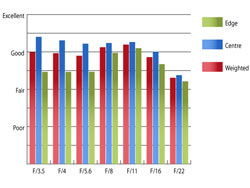 | 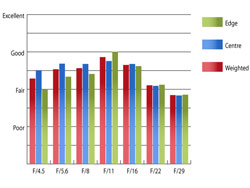 |
| Resolution at 100mm | Resolution at 270mm |
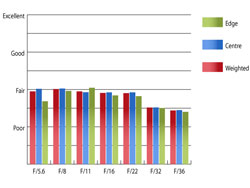 | 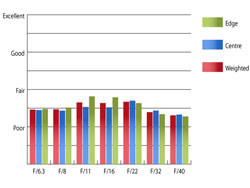 |
Chromatic aberrations are reasonably well controlled at shorter focal lengths, approaching and only just exceeding 1 pixel width at the edge of the frame. This will be barely noticeable, unless you go hunting for it. At 270mm, things get a little worse, approaching 2 pixels wide, which will be noticeable on closer examination.
| Chromatic Aberrations at 18mm | Chromatic Aberrations at 50mm |
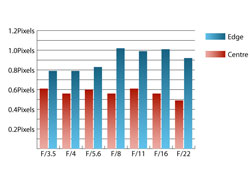 | 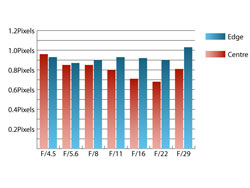 |
| Chromatic Aberrations at 100mm | Chromatic Aberrations at 270mm |
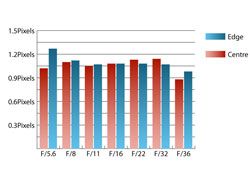 | 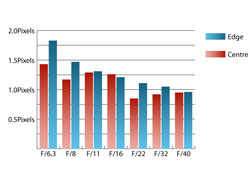 |
Light falloff towards the corners could be noticeable at 18mm. At f/3.5 the comers are 1.5 stops darker than the centre. Stopping down improves matters, but the corners are still just over half a stop darker than the centre at f/16 and f/22. At longer focal lengths, falloff is much less of an issue, with image illumination being fairly even throughout.
Distortion is always a major issue for superzoom lenses, and the Tamron 18-270mm is not an exception to the rule. 5.62% barrel distortion was recorded at 18mm, which will be highly noticeable as buildings bow out fro the centre of the image. At 270mm distortion is present, but the 1% pincushion isn't overly disturbing.
 |  |
| The pulling power of the 18-270mm is amazing, as you can see from the two shots above, taken at the lens's two extremes but from the same spot. | |
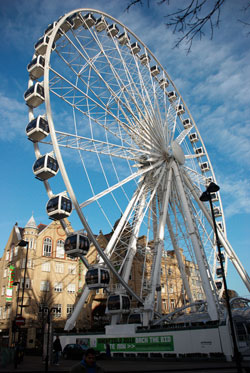 |  |
Being constructed of 18 elements in 13 groups, the flare and ghosting performance of this lens is reasonable probably due to the sheer number of glass surfaces the light has to cross before reaching the sensor. Strong sources of light in the frame cause a quite severe loss of contrast. The lens is also prone to flare at the wide end with light sources out of the frame. The supplied hood improves matters a little, but strong sources of light out towards the corners will still cause quite strong flare.
 | 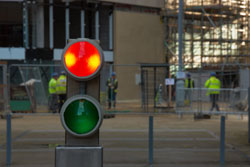 |
Tamron's Vibration Compensation system helps a lot with the slow maximum aperture of the lens, improving the sharpness of images taken at low shutter speeds. Tripod detection isn't present though, so this feature will need to be switched off when used with a support.
There is no doubt that the VC technology is very effective at getting sharper images when the light levels are low. Of course, we are not saying that VC means you can throw away the tripod, but when you are travelling light it lets you shoot for longer and that can only be a good thing.
Tamron AF 18-270mm f/3.5-6.3 Di II VC LD Aspherical: Verdict
At around £450, this is a great value lens for photographers after a portable all-in-one solution for their photography - for travel photographers, for example. Optically, it is not up to the standard of zoom lenses covering more modest focal length ranges, but that's no surprise. That said, used at its optimum apertures and with sound camera technique there is no reason why you can't get high quality pictures from this optic.
The Vibration Compensation feature adds to the convenience factor, visibly improving shots taken at slower shutter speeds.
| FEATURES |  |
| HANDLING |  |
| PERFORMANCE |  |
| VALUE |  |
| OVERALL |  |
Tamron AF 18-270mm f/3.5-6.3 Di II VC LD Aspherical: Pros
 Zoom range
Zoom range Price
Price Vibration Compensation feature
Vibration Compensation feature Light weight
Light weightTamron AF 18-270mm f/3.5-6.3 Di II VC LD Aspherical: Cons
 Slow maximum aperture
Slow maximum aperture Needs to be used at mid-apertures for best quality
Needs to be used at mid-apertures for best qualityTamron AF 18-270mm f/3.5-6.3 Di II VC LD Aspherical: Specification
| Price | £450 approx |
| Contact | Intro2020 |
| Filter Size | 72mm |
| Format | APS-C, available in Nikon & Canon mount |
| Construction | 18 elements in 13 groups |
| Angle-of-view | 75°33' - 5°55' |
| 35mm equivalent (APS-C) | 27-405mm (Nikon), 28-432 (Canon) |
| Internal focusing | Yes |
| Image stabilisation | Yes |
| Minimum focus | 49cm |
| Maximum aperture | f/3.6 - 6.3 |
| Minimum aperture | f/22 - 40 |
| Weight | 550g |
| Size | 101x79.6mm |
| In the box | Petal shaped lens hood |
The Tamron AF 18-270mm f/3.5-6.3 Di II VC LD Aspherical costs around £450 and is available from Warehouse Express here:
Tamron AF 18-270mm f/3.5-6.3 Di II VC LD Aspherical (Nikon fit)
Tamron AF 18-270mm f/3.5-6.3 Di II VC LD Aspherical (Canon fit)
Add your message
Login required
Please login here or if you've not registered, you can register here. Registering is safe, quick and free.
Please login here or if you've not registered, you can register here. Registering is safe, quick and free.
photodo Stats
1102 lenses
428 MTF tests
74 in-depth photodo reviews
100+ users join each day
Help the lens community by reviewing or rating a lens today via our lens search
428 MTF tests
74 in-depth photodo reviews
100+ users join each day
Help the lens community by reviewing or rating a lens today via our lens search
Latest Lens Reviews
- Chinon 28mm f/2.8 Vintage Lens Review
- Canon EF 70-200mm f/4L IS II USM Lens Review
- Samyang AF 85mm f/1.4 EF Review
- Sigma 70mm f/2.8 DG Macro Art Review
- Samyang AF 24mm f/2.8 FE Review
- Meike 50mm f/1.7 Review
- Tamron 70-210mm f/4 Di VC USD Review
- Lensbaby Burnside 35mm f/2.8 Review
- Asahi Super Takumar 50mm f/1.4 Review
- Asahi Super-Multi-Coated Takumar 135mm f/3.5 Review








